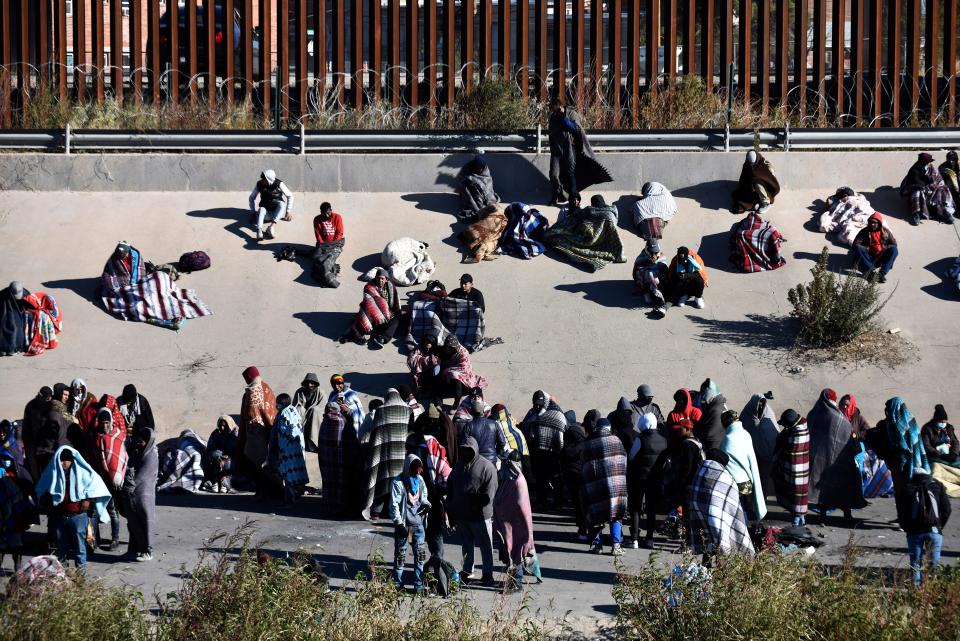Trump-era border policy set to expire in May. New rules may be no easier on border crossers
- Oops!Something went wrong.Please try again later.
- Oops!Something went wrong.Please try again later.
Title 42, the public health policy that quickly expels border-crossers – imposed by then-President Donald Trump and continued under President Joe Biden – is set to expire May 11.
But advocates and attorneys say that even without Title 42, a raft of other proposed border policies by the Biden administration could make seeking asylum at the border equally challenging.
Public health powers allowed Trump to implement the policy in March 2020 as a way of preventing the spread of COVID-19.

Since then, nearly 3 million asylum-seekers have been expelled to Mexico or their home countries, though many tried to recross into the U.S., according to statistics from U.S. Customs and Border Protection. Under Title 42, migrants are expelled quickly without having their asylum claims heard. They often end up in dangerous northern Mexican border towns awaiting a chance to apply for asylum. Other decide to cross between entry points, a journey that sometimes turns deadly.
But even as Title 42 ends, new changes the Department of Homeland Security is expected to announce this week could reinforce the challenges to seeking asylum, said Karla Marisol Vargas, a senior attorney with the Texas Civil Rights Project, a legal and advocacy group for asylum-seekers.
"All of them really seem to be focused on reducing numbers instead of focused on humane options," she said. "We have lots of concerns."
What is Title 42 and why is it ending?
Title 42 stems from a 79-year-old federal law, the Public Health Service Act, and is designed, among other things, to prevent the spread of communicable diseases. Trump invoked Title 42 through the Centers for Disease Control and Prevention in 2020, which allowed U.S. border agents to immediately expel undocumented migrants encountered along the border.
The Biden administration tried to rescind Title 42 but was blocked by various lawsuits filed by officials in Republican-led states.
Administration officials have signaled they will end the policy on May 11 after halting the country's emergency response to COVID-19.
How will ending Title 42 affect life on the border?
U.S. officials have said they expect the number of migrants at the border to double to more than 10,000 encounters a day after May 11. Even with Title 42 in place, migrants had been encountered at the U.S.-Mexico border in record numbers. Last fiscal year that ended in September, U.S. border agents encountered nearly 2.4 million asylum-seekers at the U.S.-Mexico border, a historic high, though many of them were repeat crossers, according to agency statistics.
So far this fiscal year, 1.2 million migrants have been encountered.
Though the border may see an initial spike after May 11, instability in migrants' home countries, such as political turmoil, violence and natural disasters – not White House policies – will determine how many asylum seekers arrive at the border, said Tony Payan, director of the Mexico Center at Rice University’s Baker Institute for Public Policy.

"It's a real Gordian knot," Payan said. "I don’t think there's an easy solution, Title 42 or not."
How is the Biden administration preparing for the end of Title 42?
The Biden administration has implemented or is considering several rule changes to prepare for Title 42's end. They include:
Adding Cubans, Haitians and Nicaraguans to the list of countries whose migrants could apply for temporary humanitarian parole into the U.S.
Requiring that migrants, with some exceptions, apply for asylum in a third country through which they cross before reaching the U.S.-Mexico border.
Enhancing the use of so-called expedited removals, which allow for the prompt removal of a migrant if they can't claim fear of persecution or fail their "credible fear" interview. (To claim asylum, migrants generally must show they've been persecuted in their home country.)
Administration officials point to the initiatives as steps they're taking to secure the border and prevent unauthorized asylum-seekers from entering the U.S.
But advocates said they create an unfair burden on asylum-seekers and create the same effect as Title 42: blocking migrants from seeking asylum in the U.S.
"The administration is looking to increase credible-fear denials and have a more restrictive credible-fear process that will essentially play a very similar role to Title 42," said Andrew Craycroft, a staff attorney with the Immigrant Legal Resource Center, an advocacy group.
Can anything keep Title 42 in place?
A lawsuit brought by a group of Republican-led states sought to keep Title 42 in place, arguing that removing the policy would cause an unjust economic burden on border states. The case made it to the U.S. Supreme Court, but in February, justices canceled arguments in the case after the Biden administration said it planned to end the coronavirus emergency in May, rendering the case moot.
Barring a last-minute federal filing, Title 42 should expire on May 11, Vargas said.
"Everyone right now is keeping any eye on everything, both in the courts and in the administration," she said. "Advocates' main concern is what's going to take its place."
Follow Jervis on Twitter: @MrRJervis.
This article originally appeared on USA TODAY: Title 42 set to end, but new asylum restrictions could replace it

